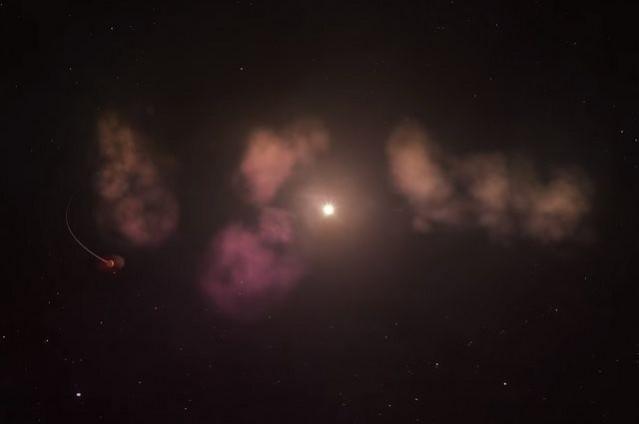
A team of US astronomers has likely solved the mystery of the unpredictable dimming of a distant star in the constellation Pisces.
Astronomers studying the star RZ Piscium, which is located 550 light-years away from Earth, have found evidence that the reason behind the random "winking" of the star could be huge orbiting clouds of gas and dust. But, where do these celestial clouds come from?
In a study, published in the journal Astronomical Journal, astronomers have revealed that RZ Piscium is capable of destroying exoplanets which rotate around it, and the rotating dust clouds appear to be the remains of one or more of these wrecked planets.
Astronomers also found that RZ Piscium's brightness drops ten-fold from time to time, for dimming episodes that can last as long as two days. It produces more energy at infrared wavelengths than other stars like our Sun, indicating that it is surrounded by a disk of warm dust.
"Our observations show there are massive blobs of dust and gas that occasionally block the star's light and are probably spiraling into it," Kristina Punzi, a doctoral student at the Rochester Institute of Technology (RIT) in New York and the study's lead author, said in a statement. "Although there could be other explanations, we suggest this material may have been produced by the break-up of massive orbiting bodies near the star."
Previously, scientists believed that RZ Piscium was a young star, surrounded by a dense belt of asteroids that frequently collide to produce dust. While scientists were never fully confident about this conclusion, an alternative view suggested that the star could be somewhat older than our Sun, with its transition into the red giant stage just being kicked off.
Using the European Space Agency's (ESA) XMM-Newton satellite, the Shane 3-meter telescope at Lick Observatory in California and the 10-meter Keck I telescope at W. M. Keck Observatory in Hawaii, scientists have now managed to determine that RZ Piscium emits X-rays that are approximately 1,000 times greater than our Sun's, proving that it's a stellar youth.
Further analysis revealed RZ Piscium's surface temperature is about 9,600 degrees Fahrenheit (5,330 degrees Celsius), which is slightly cooler than that of the Sun, and that its surface is rich in lithium.
"The amount of lithium in a star's surface declines as it ages," said Joel Kastner, director of RIT's Laboratory for Multiwavelength Astrophysics and the study's co-author, said in a statement. "Our lithium measurement for RZ Piscium is typical for a star of its surface temperature that is about 30 to 50 million years old."
However, since the dust from the star's youth would have dispersed after a few million years of its formation, RZ Piscium appeared too old to be surrounded by so much gas and dust.
"Most Sun-like stars have lost their planet-forming disks within a few million years of their birth," Ben Zuckerman, an astronomy professor at the University of California, Los Angeles, said in the statement. "The fact that RZ Piscium hosts so much gas and dust after tens of millions of years means it's probably destroying, rather than building, planets."

















